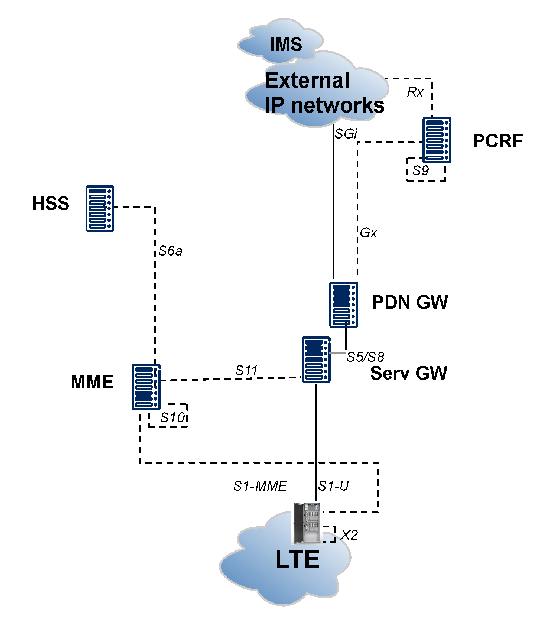

Copyright ©2019 Thomas Schwengler. A significantly updated and completed 2019 Edition is available.
Modern communication signaling isoften carried on a separate network than the actual user payload (or bearer services); this kind of signaling is called out-of-band. In the US, Signaling System 7 (SS7) is widely used and many services such as 800 numbers, caller ID, calling name, local number portability are implemented on SS7 networks. The SS7 network is a major signaling network for wireless voice services, so we review the basic of SS7 and how it applies to wireless network signaling.
SS7 lower OSI layers (physical, data link, and network) are defined by Message Transfer protocol (MTP). Transport layer is defined by SCCP. Upper layers use TCAP (Transaction Capability Application Protocol) and ISUP (Integrated Services Digital Network - ISDN User Part).
SS7 has three types of nodes or signaling points:
Actual links between these nodes are typically DS0 in North America (56kbps), also ATM or DS1 are also supported. The ITU standardizes 64kbps links and is widely used in Europe and most of Asia.
SS7 links are engineered for redundancy: STPs are always in pairs, and links are dimensioned in order to be able to sustain the additional load of another failing link. Several types of links exist in SS7: A-links (for Access links) connect an SSP to the SS7 network. B-links (for Bridge) connect an STP pair to another one as seen in figure 11.1. A-links are usually engineered for a busy hour load of 40% of capacity, so if one link to the SSP fails, the other is 80% loaded, which still sustains normal operations. The extra 20% is used to accommodate extra bursts of signals. B-links are engineered for 20% load at busy hour so as to provide redundancy upon failure of one STP and another link, or three out of the four B-links. C-links connect two STPs within a pair and insure redundancy of that node; they typically carry small amount of network management messaging, but are dimensioned to carry the total load of both STPs connected.
Wireless networks are linked by SS7 signaling network, in particular, the following entities use that network:
With these nodes, a mobile wireless network handles handoff, registration on foreign (roaming) systems, and call delivery when allowed.
Second generation wireless cellular systems brought significant improvement to wireless voice capacity; all standards in competition focused on a digital air interface and circuit switched connectivity to legacy public switched telephony networks including SS7 signaling for voice feature integration with legacy telephony networks.
The US cdmaOne network uses the TIA IS-41 or ANSI-41 standard to define interfaces and communication between major elements of the network. GSM is based on a completely different set of standards described in the GSM MAP. Although the two are very different, similar functional blocks can be identified, and the interfaces between these blocks are defined in the two families of standards. Some attempts of convergence were made, and encouraging signs appeared: Qualcomm 6300 chips allowing dual GSM-CDMA2000 modes were available in October 2002, and interoperability Interworking Function (IIF) were devised to offer transparent operations between IS-41 and GSM MAP. Nevertheless market demand never forced the wide availability for dual mode (cdma-GSM) handsets, and the two networks never reached much of an integration stage.

The LTE network relies on the Evolved Packet Core (EPC) and its Components (see figure 11.4):
Location based services (LBS) are born from an FCC mandate to provide location for emergency 911 calls. The FCC issued a mandate requiring wireless carriers to provide enhanced 911 service requiring carriers to allow 911 operators to locate callers within a certain range. In CDMA networks, a new network element, the position determination entity (PDE) is responsible locating the handset. A specific standard, IS-801, deals with position determination information. Complete 2019 Edition available here.
Small cells are low-powered radio access nodes that operate in licensed and unlicensed spectrum that have a range of tens of meters, as opposed to mobile Macro cell which might have a range of a few kilometers. Today’s mobile operators are considering using small cells for mobile data offloading as a more efficient use of radio spectrum. Given their smaller sizes, they generally allow for the highest possible modulation, thus keeping high spectrum efficiency. Complete 2019 Edition available here.
Copyright (c) 2019 Thomas Schwengler. A significantly updated and completed 2019 Edition is available.